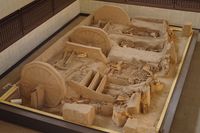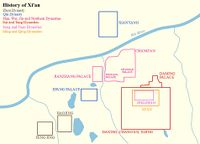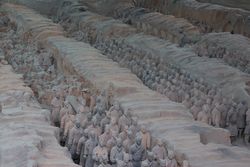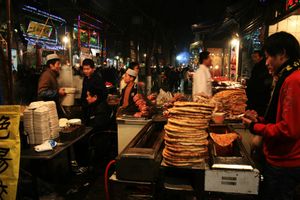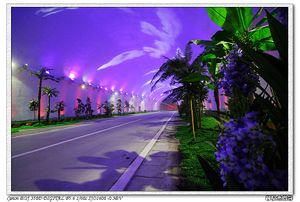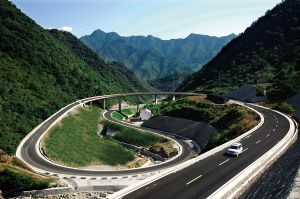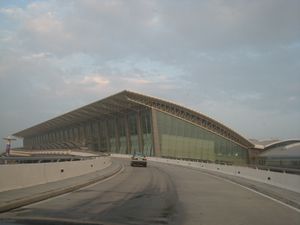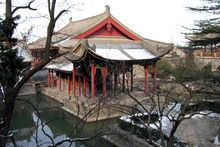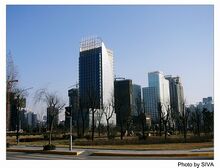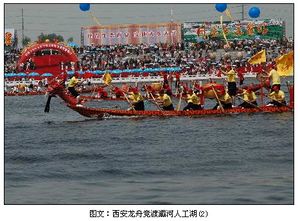شيآن
| ||||||||||||||||||||||||||||||||||||||||||||||||||||||||||||||||||||
| ||||||||||||||||||||||||||||||||||||||||||||||||||||||||||||||||||||
شيآن ( Xi'an ؛ UK /ʃiːˈæn/ shee-AN, الأمريكي /ʃiːˈɑːn/ shee-AHN;[1][2][3][4] Chinese: 西安; pinyin: Xī'ān؛ بالصينية: [ɕí.án] (![]() استمع)), أحياناً تـُرَوْمَن Sian، هي عاصمة مقاطعة شآنشي. مدينة دون المقاطعة في سهل گوانژونگ في شمال غرب الصين,[5] هي واحدة من أقدم المدن في الصين، أقدم عاصمة محافظة وواحدة من العواصم الأربع الكبرى القديمة بالصين، إذ احتفظت بالمكانة تحت العديد من أهم الأسر الحاكمة في التاريخ الصيني،[6] بما فيهم أسر ژو الغربية، چين، هان الغربية، سوي، ژو الشمالية و تانگ.[6] المدينة هي نقطة بداية طريق الحرير ومقر موقع اليونسكو للتراث الإنساني الجيش الجصي للامبراطور تشين شي هوانگ.[7]
استمع)), أحياناً تـُرَوْمَن Sian، هي عاصمة مقاطعة شآنشي. مدينة دون المقاطعة في سهل گوانژونگ في شمال غرب الصين,[5] هي واحدة من أقدم المدن في الصين، أقدم عاصمة محافظة وواحدة من العواصم الأربع الكبرى القديمة بالصين، إذ احتفظت بالمكانة تحت العديد من أهم الأسر الحاكمة في التاريخ الصيني،[6] بما فيهم أسر ژو الغربية، چين، هان الغربية، سوي، ژو الشمالية و تانگ.[6] المدينة هي نقطة بداية طريق الحرير ومقر موقع اليونسكو للتراث الإنساني الجيش الجصي للامبراطور تشين شي هوانگ.[7]
منذ ع1980، كجزء من النمو الاقتصادي للصين الداخلية خصوصاً للمناطق الوسطة والشمالية الغربية، عادت مدينة شيان إلى الظهور كمركز ثقافي وصناعي وسياسي وتعليمي لمنطقة الوسط واالشمال الغربي بأكملها، مع العديد من منشآت البحث والتطوير والأمن القومي واستكشاف الفضاء. وحالياً تحتفظ شيآن بمكانة دون المقاطعة، فتدير 11 مديرية وناحيتين.[8] المدينة هي ثالث أكبر المدن تعداداً في غرب الصين، المدينتان الأخريين هما تشونگچينگ و چنگدو، وهي كذلك أكبر المدن تعداداً في شمال غرب الصين.[9] في 2020، صُنفت شيان كمدينة-بيتا في الترتيب الزوج سنوي للمدن من شبكة أبحاث العولمة والمدن العالمية،[10] وحسب ترتيب البلد نفسها، فقد كان ترتيب شيان هو 17.[11]
بلغ إجمالي تعدادها 12,952,907 نسمة في تعداد 2020 ومساحتها المبنية (أو العمرانية) تأوي 12,283,922 نسمة، في 10 مديريات لشيان (كلهم ما عدا هويي و Yanliang اللتين لم يُدخلا في العمران بعد) و 3 Xianyang parts (Qindu and Weicheng districts and Xingping city) largely being conurbated.[12]
Xi'an is ranked in the top 40 cities in the world by scientific research output as tracked by the Nature Index,[13] and home to multiple China's prestige universities، including Northwestern Polytechnical University، Xidian University، الجامعة الشمالية الغربية، جامعة شآنشي للمعلمين، جامعة چانگآن، جامعة شيآن للعلوم والتكنولوجيا، جامعة شيآن للتكنولوجيا، جامعة شيآن للعمارة والتكنولوجيا وجامعة شآنشي للعلوم والتكنولوجيا.[14][15] أبرزهم جامعة شيآن جياوتونگ التي هي واحدة من جامعات رابطة C9 المرموقة ومركز تحالف جامعات طريق الحرير.[16]
. . . . . . . . . . . . . . . . . . . . . . . . . . . . . . . . . . . . . . . . . . . . . . . . . . . . . . . . . . . . . . . . . . . . . . . . . . . . . . . . . . . . . . . . . . . . . . . . . . . . . . . . . . . . . . . . . . . . . . . . . . . . . . . . . . . . . . . . . . . . . . . . . . . . . . . . . . . . . . . . . . . . . . . .
الإسم
"شيآن" هي atonal pinyin romanization of the Mandarin pronunciation of its name 西安, which means "Western Peace" in Chinese. (The apostrophe – known in Chinese as a 隔音符號, géyīn fúhào – should be included to distinguish its pronunciation from the single syllable xian.) The name was adopted in 1369 under the early Ming dynasty. Jesuit missionaries recorded its name as "Si-ngan" or "Si-ngan-fou"[17] from its status as the seat of a prefecture (府, fǔ). This form still appears in the Latin name of the Catholic diocese of Xi'an، archidioecesis Singanensis. The name was later romanized as "Hsi-an" by Wade & Giles and as "Sianfu"[18] or "Sian"[7] by the Qing imperial post office، both of which were common until the general adoption of pinyin.
The area of present-day Xi'an has been the site of several important former Chinese cities. The capital of the Western Zhou were the twin cities of Feng and Hao, known collectively as Fenghao, located on opposite banks of the Feng River at its confluence with the southern bank of the Wei in the western suburbs of present-day Xi'an.[19] The Qin capital Xianyang was erected north of the Wei during the Warring States period and was succeeded by the Western Han capital of Chang'an (長安), meaning "Perpetual Peace", which was located south of the Wei and covered the central area of present-day Xi'an. During the Eastern Han، Chang'an was also known as Xijing (西京) or the "Western Capital", relative to its position to the main capital at Luoyang. Under the Sui، its name became Daxing (大興, "Greatly Prosperous") in AD 581. Under the Tang، the name reverted to Chang'an in 618.[7] Under the Mongolian Yuan dynasty (13th & 14th centuries), it held a succession of names: Fengyuan (奉元), Anxi (安西, "Peaceful West") and Jingzhao (京兆). The Ming name "Xi'an" was changed back to Xijing ("Western Capital", as above) between 1930 and 1943.
التاريخ
قبل التاريخ
Xi'an has a rich and culturally significant history. The Lantian Man was discovered in 1963 in Lantian County، 50 km (31 mi) southeast of Xi'an, and dates back to at least 500,000 years before the present time. A 6,500-year-old Neolithic village, Banpo، was discovered in 1953 on the eastern outskirts of the city proper, which contains the remains of several well organized Neolithic settlements carbon dated to 5,600–6,700 years ago.[20][21][22][23] The site is now home to the Xi'an Banpo Museum، built in 1957 to preserve the archaeological collection.[24]
العصر القديم
Xi'an became a cultural and political centre of China in the 11th century BC with the founding of the Zhou dynasty. The capital of Zhou was established in the twin settlements of Fengjing (丰京) and Haojing، together known as Fenghao، located southwest of contemporary Xi'an. The settlement was also known as Zhōngzhōu to indicate its role as the capital of the vassal states.[25] In 770 BC, the capital was moved to Luoyang due to political unrest.[26]
العصر الامبراطوري
Following the Warring States period، China was unified under the Qin dynasty (221–206 BC) for the first time, with the capital located at Xianyang، just northwest of modern Xi'an.[27] The first emperor of China, Qin Shi Huang ordered the construction of the Terracotta Army and his mausoleum just to the east of Xi'an almost immediately after his ascension to the throne.[28]
In 202 BC, the founding emperor Liu Bang of the Han dynasty established his capital in Chang'an County; his first palace, Changle Palace (長樂宮, "Perpetual Happiness") was built across the river from the ruin of the Qin capital. This is traditionally regarded as the founding date of Chang'an. Two years later, Liu Bang built Weiyang Palace (未央宮, "Future Central Palace") north of modern Xi'an. Weiyang Palace was the largest palace ever built on Earth, covering 4.8 square kilometres (1,200 acres), which is 6.7 times the size of the current Forbidden City and 11 times the size of the Vatican City.[29] The original Xi'an city wall was started in 194 BC and took 4 years to finish. Upon completion, the wall measured 25.7 km (15.97 mi) in length and 12 to 16 m (39.37–52.49 ft) in thickness at the base, enclosing an area of 36 km2 (13.90 sq mi). In the year 190, amidst uprisings and rebellions just prior to the Three Kingdoms Period, a powerful warlord named Dong Zhuo moved the court from Luoyang to Chang'an in a bid to avoid a coalition of other powerful warlords against him.
بُنيت شيآن في القرن الثاني عشر قبل الميلاد، واتخذتها 21 أسرة ملكية وسلطة عاصمة لها بالتتابع. وكانت العاصمة لأسر تشو وتشن وهان وتانگ التي اُعتبرت العهود الأكثر ازدهارا في تاريخ الصين القديمة. وتُلقّب شيآن بأنها متحف تاريخي. حيث يوجد فيها التماثيل الصلصالية للجنود والخيول التي اُعتبرت المعجزة الثامنة بالعالم، إضافة إلى السور القديم الذي يعتبر أكمل طلل حفظا للسور القديم وأكبره حجما بالعالم حتى الآن.
كانت شيآن مدينة مهمة على طريق الحرير القديم، حيث لعبت دورا مهما في التبادل الثقافي بين الشرق والغرب. وهي مدينة كبيرة في شمال غربي الصين في الوقت الحاضر، وإن الاستفادة من غيرها والتواجد مع غيرها يظل مفهوما لتطور شيان وهدفا لإقامة معرض شيان العالمي للبستنة لعام 2011..[30]
سلالة هان وطريق الحرير
أسرة فريدة من نوعها
أسرة تانگ

أسرة مينگ
The Nestorian Stele، also known as the Nestorian Stone, Nestorian Monument,[31] or Nestorian Tablet, is a Tang Chinese stele erected in 781 that documents 150 years of early Christianity in China.[32] It is a 279 cm tall limestone block with text in both Chinese and Syriac describing the existence of Christian communities in several cities in northern China. It reveals that the initial Nestorian Christian church had met recognition by the Tang Emperor Taizong، due to efforts of the Christian missionary Alopen in 635.[33]
Chang'an was devastated at the end of the Tang dynasty in 904. Residents were forced to move to the new capital city in Luoyang. Only a small area in the city continued to be occupied thereafter. During the Ming dynasty، a new wall was constructed in 1370 and remains intact to this day. The wall measures 11.9 km (7.4 mi) in circumference، 12 m (39.37 ft) in height, and 15 to 18 m (49.21–59.06 ft) in thickness at the base; a moat was also built outside the walls. The new wall and moat would protect a much smaller city of 12 km2 (4.6 sq mi).
. . . . . . . . . . . . . . . . . . . . . . . . . . . . . . . . . . . . . . . . . . . . . . . . . . . . . . . . . . . . . . . . . . . . . . . . . . . . . . . . . . . . . . . . . . . . . . . . . . . . . . . . . . . . . . . . . . . . . . . . . . . . . . . . . . . . . . . . . . . . . . . . . . . . . . . . . . . . . . . . . . . . . . . .
العصر الحديث
In October 1911, during the revolution in which the Qing dynasty was overthrown, revolutionary forces massacred 20,000 Manchus in the process in the northeastern zone within Xi'an's city walls, wiping out the entire Manchu population in the city.[34][35]
In 1936, the Xi'an Incident took place inside the city during the Chinese Civil War. The incident brought the Kuomintang (KMT) and Communist Party of China to a truce in order to concentrate on fighting against the Japanese Invasion.[36] On May 20, 1949, the Communist-controlled People's Liberation Army captured the city of Xi'an from the Kuomintang force.[37]
Xi'an made headlines for being one of the many cities where the 2012 China anti-Japanese demonstrations occurred.[38][39][40]
الجغرافيا والمناخ


Xi'an lies on the Guanzhong Plain in the south-central part of Shaanxi province, on a flood plain created by the eight surrounding rivers and streams. The urban area of Xi'an is located at 34°16′N 108°56′E / 34.267°N 108.933°E.
The city borders the northern foot of the Qin Mountains (Qinling) to the south, and the banks of the Wei River to the north. Hua Shan، one of the five sacred Taoist mountains, is located 100 km (62 mi) away to the east of the city. Not far to the north is the Loess Plateau.
At the beginning of Han dynasty, Prime Minister Zhang Liang advised the emperor Liu Bang to choose Guanzhong as the capital of the Han dynasty: "Guanzhong Plain, which is located behind Xiao Pass and Hangu Pass, connects Long (Gansu) and Shu (Sichuan). Lands of thousand miles rich in harvest be found here, as if this place belongs to the nation of heaven." (关中左崤函,右陇蜀,沃野千里,此所谓金城千里,天府之国也) Since then, Guanzhong is also known as the 'Nation of the Heaven'.[41]
المناخ
| شيآن | ||||||||||||||||||||||||||||||||||||||||||||||||||||||||||||
|---|---|---|---|---|---|---|---|---|---|---|---|---|---|---|---|---|---|---|---|---|---|---|---|---|---|---|---|---|---|---|---|---|---|---|---|---|---|---|---|---|---|---|---|---|---|---|---|---|---|---|---|---|---|---|---|---|---|---|---|---|
| جدول طقس (التفسير) | ||||||||||||||||||||||||||||||||||||||||||||||||||||||||||||
| ||||||||||||||||||||||||||||||||||||||||||||||||||||||||||||
| ||||||||||||||||||||||||||||||||||||||||||||||||||||||||||||
Xi'an has a temperate climate that is influenced by the East Asian monsoon، classified under the Köppen climate classification as situated on the borderline between a semi-arid climate (BSk) and humid subtropical climate (Cwa). The Wei River valley is characterised by hot, humid summers, cold, dry winters, and dry springs and autumns. Most of the annual precipitation is delivered from July to late October. Snow occasionally falls in winter but rarely settles for long. Dust storms often occur during March and April as the city rapidly warms up. Summer months also experience frequent but short thunderstorms. The monthly 24-hour average temperature ranges from around the freezing mark in January to 27.0 °C (80.6 °F) in July, with an annual mean of 14.08 °C (57.3 °F). With monthly percent possible sunshine ranging from 31 percent in December to 47 percent in August, the city receives 1,536 hours of bright sunshine annually. Extremes since 1951 have ranged from −20.6 °C (−5 °F) on January 11, 1955 to 41.8 °C (107 °F) on June 21, 1998. A highest record of 42.9 °C (109 °F) was registered in another station on June 17, 2006.[42][43]
| Climate data for Xi'an (normals 1981–2010, extremes 1951–2013) | |||||||||||||
|---|---|---|---|---|---|---|---|---|---|---|---|---|---|
| Month | Jan | Feb | Mar | Apr | May | Jun | Jul | Aug | Sep | Oct | Nov | Dec | Year |
| Record high °C (°F) | 17.0 (62.6) |
24.1 (75.4) |
31.3 (88.3) |
34.9 (94.8) |
38.6 (101.5) |
41.8 (107.2) |
41.0 (105.8) |
40.0 (104.0) |
38.5 (101.3) |
34.1 (93.4) |
24.5 (76.1) |
21.6 (70.9) |
41.8 (107.2) |
| Mean daily maximum °C (°F) | 5.1 (41.2) |
8.9 (48.0) |
14.4 (57.9) |
21.5 (70.7) |
26.6 (79.9) |
31.4 (88.5) |
32.4 (90.3) |
30.3 (86.5) |
25.6 (78.1) |
19.3 (66.7) |
12.4 (54.3) |
6.3 (43.3) |
19.5 (67.1) |
| Daily mean °C (°F) | 0.3 (32.5) |
3.6 (38.5) |
8.7 (47.7) |
15.4 (59.7) |
20.5 (68.9) |
25.3 (77.5) |
27.0 (80.6) |
25.1 (77.2) |
20.3 (68.5) |
14.1 (57.4) |
7.2 (45.0) |
1.5 (34.7) |
14.1 (57.4) |
| Mean daily minimum °C (°F) | −3.3 (26.1) |
−0.4 (31.3) |
4.1 (39.4) |
10.3 (50.5) |
15.1 (59.2) |
19.9 (67.8) |
22.3 (72.1) |
21.0 (69.8) |
16.5 (61.7) |
10.2 (50.4) |
3.2 (37.8) |
−2.2 (28.0) |
9.7 (49.5) |
| Record low °C (°F) | −20.6 (−5.1) |
−18.7 (−1.7) |
−7.6 (18.3) |
−4 (25) |
3.5 (38.3) |
9.2 (48.6) |
15.1 (59.2) |
12.1 (53.8) |
4.8 (40.6) |
−1.9 (28.6) |
−16.8 (1.8) |
−19.3 (−2.7) |
−20.6 (−5.1) |
| Average precipitation mm (inches) | 6.7 (0.26) |
9.8 (0.39) |
27.1 (1.07) |
37.5 (1.48) |
54.9 (2.16) |
64.5 (2.54) |
97.5 (3.84) |
78.6 (3.09) |
94.1 (3.70) |
61.7 (2.43) |
21.5 (0.85) |
7.3 (0.29) |
561.2 (22.1) |
| Average precipitation days (≥ 0.1 mm) | 3.4 | 4.0 | 6.4 | 7.8 | 8.2 | 8.8 | 9.9 | 10.0 | 11.6 | 9.9 | 5.5 | 3.6 | 89.1 |
| Average relative humidity (%) | 65 | 62 | 64 | 64 | 65 | 61 | 68 | 75 | 77 | 76 | 73 | 68 | 68 |
| Mean monthly sunshine hours | 88.4 | 96.1 | 116.6 | 142.8 | 169.5 | 179.7 | 181.1 | 168.1 | 121.0 | 98.9 | 92.4 | 81.0 | 1٬535٫6 |
| Percent possible sunshine | 32 | 34 | 33 | 38 | 40 | 43 | 44 | 47 | 34 | 32 | 32 | 31 | 37 |
| Source: China Meteorological Administration,[44] all-time extreme temperature[43] | |||||||||||||
. . . . . . . . . . . . . . . . . . . . . . . . . . . . . . . . . . . . . . . . . . . . . . . . . . . . . . . . . . . . . . . . . . . . . . . . . . . . . . . . . . . . . . . . . . . . . . . . . . . . . . . . . . . . . . . . . . . . . . . . . . . . . . . . . . . . . . . . . . . . . . . . . . . . . . . . . . . . . . . . . . . . . . . .
الديمغرافيا
اعتبارا من 2015[تحديث] Xi'an has a population of 8.7 million.[45] Compared to the census data from 2000, the population has increased by 656,700 persons from 7.41 million.[46] The population is 51.66 percent male and 48.34 percent female.[46] Among its districts, Yanta has the largest population, with 1.08 million inhabitants.[46]
The majority of Xi'an residents are Han Chinese، who make up 99.1 percent of the city's total population. There are around 81,500 people belonging to ethnic minorities living in Xi'an, including 50,000 Hui people.[بحاجة لمصدر]
During World War II, Xi'an became a destination for many refugees from other provinces of China, especially neighboring Henan Province. Because Xi'an was far inland, the invading Japanese army only managed a few aerial assaults on the city. As a result, Xi'an suffered minimal destruction. After 1949, the national government tried to balance the development in different regions of China, and relocated a number of factories and universities from other cities to Xi'an. Modern Xi'an Jiaotong University was relocated from its original campus in Shanghai.
| Division | Permanent residents[47] | Hukou residents[48] | ||
|---|---|---|---|---|
| Total | Percentage | Population density (persons/km2) | ||
| Xi'an City | 8,467,837 | 100 | 838.66 | 7,827,260 |
| Xincheng District | 589,739 | 6.96 | 19,574.51 | 503,641 |
| Beilin District | 614,710 | 7.26 | 26,298.54 | 732,494 |
| Lianhu District | 698,513 | 8.25 | 18,226.61 | 640,911 |
| Baqiao District | 595,124 | 7.03 | 1,833.97 | 508,535 |
| Weiyang District | 806,811 | 9.53 | 3,051.39 | 516,968 |
| Yanta District | 1,178,529 | 13.92 | 7,782.38 | 793,103 |
| Yanliang District | 278,604 | 3.29 | 1,139.26 | 252,449 |
| Lintong District | 655,874 | 7.75 | 716.04 | 697,586 |
| Chang'an District | 1,083,285 | 12.79 | 681.94 | 980,803 |
| Gaoling District | 333,477 | 3.94 | 1,169.98 | 294,507 |
| Huyi District | 556,377 | 6.57 | 434.87 | 597,071 |
| Lantian County | 514,026 | 6.07 | 256.25 | 643,605 |
| Zhouzhi County | 562,768 | 6.65 | 191.08 | 665,587 |
التقسيمات الادارية
The sub-provincial city of Xi'an has direct jurisdiction over 11 districts and 2 counties:
| Map | ||||||||||||
|---|---|---|---|---|---|---|---|---|---|---|---|---|
| Division code[49] | English | Chinese | Pinyin | Area in km2[50] | Seat | Postal code | Subdivisions[51] | |||||
| Subdistricts | Towns | Residential communities | Villages | |||||||||
| 610100 | Xi'an | 西安市 | Xī'ān Shì | 10,096.81 | Weiyang District | 710000 | 113 | 55 | 766 | 2984 | ||
| 610102 | Xincheng District | 新城区 | Xīnchéng Qū | 30.13 | Xiyi Road Subdistrict (西一路街道) |
710000 | 9 | 105 | ||||
| 610103 | Beilin District | 碑林区 | Bēilín Qū | 23.37 | Zhangjiacun Subdistrict (张家村街道) |
710000 | 8 | 100 | ||||
| 610104 | Lianhu District | 莲湖区 | Liánhú Qū | 38.32 | Beiyuanmen Subdistrict (北院门街道) |
710000 | 9 | 127 | 5 | |||
| 610111 | Baqiao District | 灞桥区 | Bàqiáo Qū | 324.50 | Fangzhicheng Subdistrict (纺织城街道) |
710000 | 9 | 40 | 223 | |||
| 610112 | Weiyang District | 未央区 | Wèiyāng Qū | 264.41 | Zhangjiabao Subdistrict (张家堡街道) |
710000 | 12 | 114 | 147 | |||
| 610113 | Yanta District | 雁塔区 | Yàntǎ Qū | 151.44 | Xiaozhai Road Subdistrict (小寨路街道) |
710000 | 8 | 123 | 84 | |||
| 610114 | Yanliang District | 阎良区 | Yánliáng Qū | 244.55 | Fenghuang Road Subdistrict (凤凰路街道) |
710089 | 5 | 2 | 23 | 80 | ||
| 610115 | Lintong District | 临潼区 | Líntóng Qū | 915.97 | Lishan Subdistrict (骊山街道) |
710600 | 23 | 36 | 284 | |||
| 610116 | Chang'an District | 长安区 | Cháng'ān Qū | 1,588.53 | Weiqu Subdistrict (韦曲街道) |
710100 | 25 | 47 | 659 | |||
| 610117 | Gaoling District | 高陵区 | Gāolíng Qū | 285.03 | Luyuan Subdistrict (鹿苑街道) |
710200 | 3 | 3 | 8 | 88 | ||
| 610118 | Huyi District | 鄠邑区 | Hùyì Qū | 1,279.42 | Ganting Subdistrict (甘亭街道) |
710300 | 1 | 13 | 21 | 518 | ||
| 610122 | Lantian County | 蓝田县 | Lántián Xiàn | 2,005.95 | Languan Subdistrict (蓝关街道) |
710500 | 1 | 18 | 8 | 520 | ||
| 610124 | Zhouzhi County | 周至县 | Zhōuzhì Xiàn | 2,945.20 | Erqu Subdistrict (二曲街道) |
710400 | 1 | 19 | 14 | 376 | ||
النقل والبنية التحتية
المترو
القطارات
الطرق السريعة
المطارات
الثقافة
فن العمارة
الديانات
البوذية
البوذية التبتية
الإسلام
Xi'an was the first city in China to be introduced to Islam. Emperor Gaozong of the Tang dynasty officially allowed the practice of Islam in AD 651. Xi'an has a large Muslim community, the significant majority are from the Hui group, there are an estimated 50,000 Hui Muslims in Xi’an.[52] There are seven mosques in Xi'an, the best known being the Great Mosque.[53]
الاقتصاد
As part of the China Western Development policy, Xi’an became a major target for accelerated attention. From 1997 to 2006, the industrial output value of Xi’an's service industry increased at an annual average rate of 13 percent, compared to traditional service industries of 0.74 percent, representing a growth from US$8.113 billion to US$25.85 billion.[54] Xi'an is the largest economy of the Shaanxi province, with a GDP of 324.1 billion Yuan in 2010. On average this value increases by 14.5 percent annually, and accounts for approximately 41.8 percent of Shaanxi's total GDP.[54][55] At least fifty-eight countries have established over 2,560 enterprises in Xi'an, including nineteen of the Fortune 500 enterprises. These include ABB, Mitsubishi, Panasonic, Toshiba, Fujitsu, Coca-Cola Company and Boeing.[56]
In 2020, Xi'an was ranked as a Beta- (global second tier) city by the Globalization and World Cities Research Network.[57] Xi'an is also one of the world's top 100 financial centers, according to the Global Financial Centres Index.[58]
Important industries include equipment manufacturing, tourism, and service outsourcing.[59] The manufacturing industry had an annual output of RMB 36.5 billion, accounting for 44.5 percent of the city's total.[55] Furthermore, as one of China's four ancient capitals,[60] Xi'an's many cultural sites, including the Terracotta Army, the City Wall of Xi'an, and the Famen Temple, make tourism an important industry as well. In 2010, 52 million domestic tourists visited Xi'an, earning a total income of RMB 40.52 billion. On average, revenue increases by 36.4 percent per year, and foreign-exchange earnings (530 million in 2009) increase by around 35.8 percent.[55]
Xi'an is also one of the first service outsourcing cities in China, with over 800 corporations in the industry. The city's output value from this sector exceeded RMB 23 billion in 2008. Employment in the sector doubled from 1997 to 2006, from a base of 60,000, and computer consulting also doubled from 16,000 to 32,000.[54] As a result of the importance of the software-outsourcing industry, the city planned construction of a Software New Town, which is scheduled to be completed in 2015 with 30 billion RMB investment.[55] Other major export goods include lighting equipment and automobile parts, while its major import goods are mechanical and electrical products. Internationally, Xi'an's largest trade partner is the United States.[55]
صناعات البرمجيات والتكنولوجيا
The major industrial zone in Xi'an is the Xi'an Economic and Technological Development Zone. The Jiangcungou landfill in Xi'an was China's largest landfill site before its closure in 2019.[61]
The growing economy of the city also supports the development of a software industry, and the city is a pioneer in software industry in China. The Xi'an Software Park within the Xi'an Hi-Tech Industries Development Zone (XDZ) has attracted over 1,085 corporations and 106,000 employees as of 2012.[62] Xi'an is described as having" large pool of cheap human resources from the 100 universities in the area, it hoovers up around 3,000 computer graduates every year, each earning approximately $120 a month—half the wages for the equivalent job in Beijing."[63][64]
الصناعات الجوفضائية
In November 2006, Xi'an and the China Aerospace Science and Technology Corporation jointly set up Xi'an Aerospace Science and Technology Industrial Base. From its establishment, the base has focused on the development of the civil space industry, including equipment manufacturing, software and service outsourcing, new materials and solar photovoltaics.
Apart from the core area, the base will cover Xi'an and the Guanzhong area and the expansion zone ستصل أجزاء أخرى من شمال غرب الصين وجنوب غرب الصين. It is expected that by 2012 the total industry output can reach 2.8 billion us dollars with about 10 to 20 brand products with intellectual property rights and 5 to 8 products with global competitiveness.
In 2008, after the launch of the initial aerospace centre in Shanghai, the PRC is constructing another civil aerospace centre in the Shaanxi province. The State Development and Reform Commission approved the planning of Xi'an National Civil Aerospace Industrial Base on December 26, 2007. The National Civil Aerospace Industrial Base of Xi'an, set to cover 23 km2 (8.9 sq mi), will focus on developing satellites, new materials, energies, IT and other technologies for civil applications.[65]
السياحة
وسائل الإعلام
الرياضة
معرض الصور
المدن الشقيقة
Xi'an's sister cities are:
 نارا، اليابان. (1974)
نارا، اليابان. (1974) كيوتو، اليابان. (1974)
كيوتو، اليابان. (1974) إدنبرة، إسكتلندا. (1985)
إدنبرة، إسكتلندا. (1985) پو، فرنسا. (1986)
پو، فرنسا. (1986) مدينة كانزس، مزوري. (1989)
مدينة كانزس، مزوري. (1989) أصفهان، إيران. (1989)
أصفهان، إيران. (1989) دورتموند، ألمانيا. (1991)
دورتموند، ألمانيا. (1991) لاهور، باكستان. (1992)
لاهور، باكستان. (1992) فوناباشي، اليابان. (1994)
فوناباشي، اليابان. (1994) Gyeongju، كوريا الجنوبية. (1994)
Gyeongju، كوريا الجنوبية. (1994) Iaşi، رومانيا. (1994)
Iaşi، رومانيا. (1994) دنيپروپتروڤسك، أوكرانيا. (1995)
دنيپروپتروڤسك، أوكرانيا. (1995) إسطنبول، تركيا. (1996)
إسطنبول، تركيا. (1996) كاتمندو، نيبال. (1996)
كاتمندو، نيبال. (1996) برازيليا، البرازيل. (1997)
برازيليا، البرازيل. (1997) كويبك سيتي، كويبك، كندا. (2001)
كويبك سيتي، كويبك، كندا. (2001) كوردوبا، الأرجنتين. (2006)
كوردوبا، الأرجنتين. (2006) پومپي، إيطاليا. (2007)
پومپي، إيطاليا. (2007) برمنجهام، إنجلترا.
برمنجهام، إنجلترا. كوسكو، بيرو.
كوسكو، بيرو.
الهامش
- ^ "Xi'an". The American Heritage Dictionary of the English Language (5th ed.). HarperCollins. Retrieved April 14, 2019.
- ^ "Xi'an". Collins English Dictionary. HarperCollins. Archived from the original on April 14, 2019. Retrieved April 14, 2019.
- ^ "Xian" Archived أبريل 14, 2019 at the Wayback Machine (US) and قالب:Cite Oxford Dictionaries
- ^ قالب:Cite Merriam-Webster
- ^ "Illuminating China's Provinces, Municipalities and Autonomous Regions". PRC Central Government Official Website. Archived from the original on December 24, 2014. Retrieved 2014-05-17.
- ^ أ ب Xi'an. September 3, 2008. Archived from the original on February 28, 2008. Retrieved February 6, 2016.
{{cite encyclopedia}}:|work=ignored (help) - ^ أ ب ت "Xi'an". Encyclopædia Britannica. Archived from the original on December 4, 2008. Retrieved 2008-09-03.
- ^ 中央机构编制委员会印发《关于副省级市若干问题的意见》的通知. 中编发[1995]5号. 豆丁网. Archived from the original on May 29, 2014. Retrieved May 28, 2014.
- ^ 最新中国城市人口数量排名(根据2010年第六次人口普查). www.elivecity.cn. 2012. Archived from the original on March 3, 2015. Retrieved 2014-05-27.
- ^ "GaWC - The World According to GaWC 2020". www.lboro.ac.uk. Retrieved 2021-06-25.
- ^ 上海证券报 (2021-05-21). "中国百强城市榜单发布,你的城市上榜了吗?". finance.sina.com.cn. Retrieved 2021-06-25.
- ^ "China: Shaanxi (Prefectures, Cities, Districts and Counties) - Population Statistics, Charts and Map".
- ^ "Nature Index 2020 Science Cities | Supplements | Nature Index". www.natureindex.com. Retrieved 2020-10-15.
- ^ "US News Best Global Universities Rankings in Xi'an". U.S. News & World Report. 2021-10-26. Retrieved 2021-10-26.
{{cite web}}: CS1 maint: url-status (link) - ^ "Nature Index 2018 Science Cities | Nature Index Supplements | Nature Index". www.natureindex.com. Retrieved 2020-10-15.
- ^ "University collaboration takes the Silk Road route". University World News. 12 June 2015. Retrieved 2021-10-30.
{{cite web}}: CS1 maint: url-status (link) - ^ خطأ: الوظيفة "harvard_core" غير موجودة.; خطأ: الوظيفة "harvard_core" غير موجودة.
- ^ خطأ: الوظيفة "harvard_core" غير موجودة.
- ^ , Shanghai: Shanghai Cishu Chubanshe, 2005, p. 1540
- ^ Yang, Xiaoping (2010). "Climate Change and Desertification with Special Reference to the Cases in China". Changing Climates, Earth Systems and Society. pp. 177–187. doi:10.1007/978-90-481-8716-4_8. ISBN 978-90-481-8715-7.
- ^ Stark, Miriam T (2008-04-15). "East Asian plant domestication". Archaeology of Asia. pp. 77–95. ISBN 9781405153034.
- ^ Fuller, Dorian Q; Qin, Ling; Harvey, Emma (2008). "A Critical Assessment of Early Agriculture in East Asia, with emphasis on Lower Yangzte Rice Domestication" (PDF). Pragdhara: 17–52. Archived (PDF) from the original on September 24, 2015. Retrieved May 28, 2014.
- ^ Meng, Y; Zhang, HQ; Pan, F; He, ZD; Shao, JL; Ding, Y (2011). "Prevalence of dental caries and tooth wear in a Neolithic population (6700-5600 years BP) from northern China". Archives of Oral Biology. 56 (11): 1424–35. doi:10.1016/j.archoralbio.2011.04.003. PMID 21592462.
- ^ "Banpo Museum in Xi'an". chinamuseums.com. Archived from the original on January 31, 2018. Retrieved 2013-07-29.
- ^ Third scroll of the Chang'an Annals (长安志) interpreted by Huangfu Mi in his Age of Kings (book) (帝王世紀)
- ^ "China's six major historical capitals - Xi'an's cultural history". Archived from the original on 2011-02-22. Retrieved 2011-02-22.
- ^ 中国古今地名大词典 (in الصينية المبسطة). Shanghai: 上海辞书出版社. 2005. p. 2134.
- ^ O. Louis Mazzatenta. "Emperor Qin's Terracotta Army". National Geographic.
- ^ "Weiyang Palace: the Largest Palace Ever Built on Earth". Archived from the original on مارس 3, 2016. Retrieved نوفمبر 4, 2014.
{{cite web}}: Unknown parameter|dead-url=ignored (|url-status=suggested) (help) - ^ "شيآن". شيآن - إذاعة الصين الدولية.
- ^ Saeki, Yoshiro (1928) [1916]. The Nestorian monument in China. Society for Promoting Christian Knowledge.
- ^ Hill, Henry, ed (1988). Light from the East: A Symposium on the Oriental Orthodox and Assyrian Churches. Toronto, Canada. pp. 108–109
- ^ Jenkins, Peter (2008). The Lost History of Christianity: the Thousand-Year Golden Age of the Church in the Middle East, Africa, and Asia - and How It Died. New York: Harper Collins. p. 65. ISBN 978-0-06-147280-0.
- ^ Ernest Frank Borst-Smith, Caught in the Chinese Revolution: a record of risks and rescue. London: T. Fisher Unwin، 1912.
- ^ Edward J. M. Rhoads (2000). Manchus and Han: Ethnic Relations and Political Power in Late Qing and Early Republican China, 1861–1928. University of Washington. p. 190.
- ^ Guo Rugui,中国抗日战争正面战场作战记 ,第二部分:从“九一八”事变到西安事变 绥远抗战的巨大影响和军事上的经验
- ^ "Public Government Policy" (in Chinese). City of Xi'an. Archived from the original on 2011-02-22. Retrieved 2011-02-22.
{{cite web}}: CS1 maint: unrecognized language (link) - ^ 打砸抢烧不是爱国是害民. 北京青年报 (in Chinese). 2012-09-16. Retrieved 2012-09-16.
{{cite news}}: CS1 maint: unrecognized language (link) - ^ "Xi'an Protesters Overturn Cars". Retrieved 2012-09-17.[dead link]
- ^ "Anti-Japan Protests In China Swell, Turn Violent". Huffington Post. 2012-09-15. Retrieved 2012-09-17.
- ^ 《史记·留侯世家》[استشهاد ناقص]
- ^ "Archived copy". Archived from the original on 2013-03-18. Retrieved 2013-02-18.
{{cite web}}: Unknown parameter|deadurl=ignored (|url-status=suggested) (help)CS1 maint: archived copy as title (link) - ^ أ ب "Extreme Temperatures Around the World". Retrieved 2013-02-21.
- ^ 中国气象局 国家气象信息中心 (in Chinese). China Meteorological Administration. June 2011. Archived from the original on 2009-07-16. Retrieved 2009-03-17.
{{cite web}}: Unknown parameter|deadurl=ignored (|url-status=suggested) (help)CS1 maint: unrecognized language (link) - ^ 西安市2015年国民经济和社会发展统计公报. www.xatj.gov.cn/. Archived from the original on 4 June 2016. Retrieved 2016-05-12.
- ^ أ ب ت 西安人口 [Xi'an population] (in الصينية). City of Xi'an. Archived from the original on 2007-03-22. Retrieved 2007-05-16.
{{cite web}}: Unknown parameter|deadurl=ignored (|url-status=suggested) (help) - ^ "西安市2010年第六次全国人口普查主要数据公报" (in الصينية). Xi'an Evening News (西安晚报). May 25, 2011. Retrieved 2014-07-03.
- ^ People's Republic of China County-level Division Population Statistics (《中华人民共和国全国分县市人口统计资料2010》).
- ^ 国家统计局统计用区划代码 Archived أبريل 7, 2012 at the Wayback Machine
- ^ 《贵阳统计年鉴2011》
- ^ 《中国民政统计年鉴2011》
- ^ 中国七大中心城市人口资源大调查 "Population survey of the seven central cities of China", Zhang Zhizhong, National Family Planning Commission
- ^ Mosques in Xian from www.muslim2china.com
- ^ أ ب ت Walcott, Susan (April 17, 2010). "Xi'an's Maturing Economy". Retrieved 2013-06-01.
- ^ أ ب ت ث ج "Xi'an ( Shaanxi ) City Information". أغسطس 29, 2011. Archived from the original on مايو 5, 2015. Retrieved يونيو 1, 2013.
- ^ "City Report: Xi'an". يناير 17, 2007. Archived from the original on أكتوبر 3, 2014. Retrieved يونيو 2, 2013.
- ^ خطأ استشهاد: وسم
<ref>غير صحيح؛ لا نص تم توفيره للمراجع المسماة:1 - ^ خطأ استشهاد: وسم
<ref>غير صحيح؛ لا نص تم توفيره للمراجع المسماةGFCI - ^ "Xi'an Economy". The People's Government of Shaanxi. يناير 1, 2008. Archived from the original on مارس 3, 2016. Retrieved يونيو 2, 2013.
- ^ "Xi'an". Lehman, Lee & Xu. Retrieved 2013-06-02.
- ^ "China's mega-dump already full – 25 years early". BBC News. 15 November 2019. Archived from the original on December 3, 2019. Retrieved 15 November 2019.
- ^ "Xi'an software park". www.xdz.com. Archived from the original on February 11, 2018. Retrieved 2018-02-10.
- ^ "People's Daily". Archived from the original on September 4, 2008. Retrieved October 1, 2007.
- ^ Bureau of Commerce of Xi'an Municipal Government Archived أكتوبر 16, 2012 at the Wayback Machine
- ^ Reuters Staff (2015-03-11). "China military aircraft to see tech "breakthroughs" this year -Xinhua". Reuters (in الإنجليزية). Retrieved 2021-06-24.
{{cite news}}:|author=has generic name (help)
وصلات خارجية
- China Travel Guide, Xi'an (English, Chinese)
- شيآن travel guide from Wikitravel
- Official Tourism Website of Xi'an (options: Chinese, English, Japanese, Korean, Russian)
- Municipal government website (In Chinese)
- Reconstruction of Tang Period Chang'an(in English)
- Xi'an National Hi-tech development zone (Chinese/English/Japanese)
- Photos of Xi'an (English)
- Official website of Drum Tower and Bell tower (Chinese/English)
- Official website of Huaqing Pool (Chinese/English/French/Japanese)
- Official website of Qin Epang Gong (Chinese/English)
- Photos of Xi'an (Chinese)
- Map of Xi'an (Chinese)
- Satellite images of Xi'an (Google Maps)
- Xi'an map (بالصينية)
- Atmosphere at the Xian Railway Station - video
- Slideshow of Xi'an sights (English)
| سبقه يين |
عاصمة الصين (بإسم هاو) 1046 ق.م.-771 ق.م. |
تبعه لوويانگ |
| سبقه Xianyang |
عاصمة الصين (بإسم Chang'an) 206 ق.م.-25 |
تبعه لوويانگ |
| سبقه لوويانگ |
عاصمة الصين (بإسم Chang'an) 190-196 |
تبعه Xuchang |
| سبقه Jiankang |
عاصمة الصين (بإسم Daxing) 581-618 |
تبعه نفسها، بإسم Chang'an |
| سبقه itself, as داشينگ |
عاصمة الصين (بإسم Chang'an) 618-907 |
تبعه Kaifeng |
| أكبر مدن أو بلديات في جمهورية الصين الشعبية
China Urban Construction Statistical Yearbook 2020 Urban Population and Urban Temporary Population | |||||||||
|---|---|---|---|---|---|---|---|---|---|
| الترتيب | المقاطعة | التعداد | الترتيب | المقاطعة | التعداد | ||||
 شنغهاي  بكين |
1 | شنغهاي | SH | 24,281,400 | 11 | Hong Kong | HK | 7,448,900 |  Guangzhou  Shenzhen |
| 2 | بكين | BJ | 19,164,000 | 12 | Zhengzhou | HA | 7,179,400 | ||
| 3 | Guangzhou | GD | 13,858,700 | 13 | Nanjing | JS | 6,823,500 | ||
| 4 | Shenzhen | GD | 13,438,800 | 14 | Xi'an | SN | 6,642,100 | ||
| 5 | Tianjin | TJ | 11,744,400 | 15 | Jinan | SD | 6,409,600 | ||
| 6 | Chongqing | CQ | 11,488,000 | 16 | Shenyang | LN | 5,900,000 | ||
| 7 | Dongguan | GD | 9,752,500 | 17 | Qingdao | SD | 5,501,400 | ||
| 8 | Chengdu | SC | 8,875,600 | 18 | هاربين | HL | 5,054,500 | ||
| 9 | ووهان | HB | 8,652,900 | 19 | Hefei | AH | 4,750,100 | ||
| 10 | Hangzhou | ZJ | 8,109,000 | 20 | Changchun | JL | 4,730,900 | ||
- Pages using gadget WikiMiniAtlas
- CS1 errors: periodical ignored
- CS1 uses الصينية-language script (zh)
- CS1 maint: url-status
- Articles containing صينية-language text
- CS1 الصينية المبسطة-language sources (zh-hans)
- CS1 errors: unsupported parameter
- Articles with dead external links from July 2018
- Articles with incomplete citations from May 2020
- All articles with incomplete citations
- CS1 الصينية-language sources (zh)
- Articles containing simplified Chinese-language text
- CS1 errors: generic name
- Short description is different from Wikidata
- Coordinates on Wikidata
- Articles containing Chinese-language text
- Articles containing لاتينية-language text
- Articles with hatnote templates targeting a nonexistent page
- مقالات فيها عبارات متقادمة منذ 2015
- جميع المقالات التي فيها عبارات متقادمة
- Articles with unsourced statements from July 2012
- أماكن مأهولة على طريق الحرير
- Cities in Shaanxi
- مدن دون مستوى مقاطعة في جمهورية الصين الشعبية
- شيآن
- تأسيسات القرن 11 ق.م.
- تأسيسات 202 ق.م.
- عواصم المقاطعات في الصين



